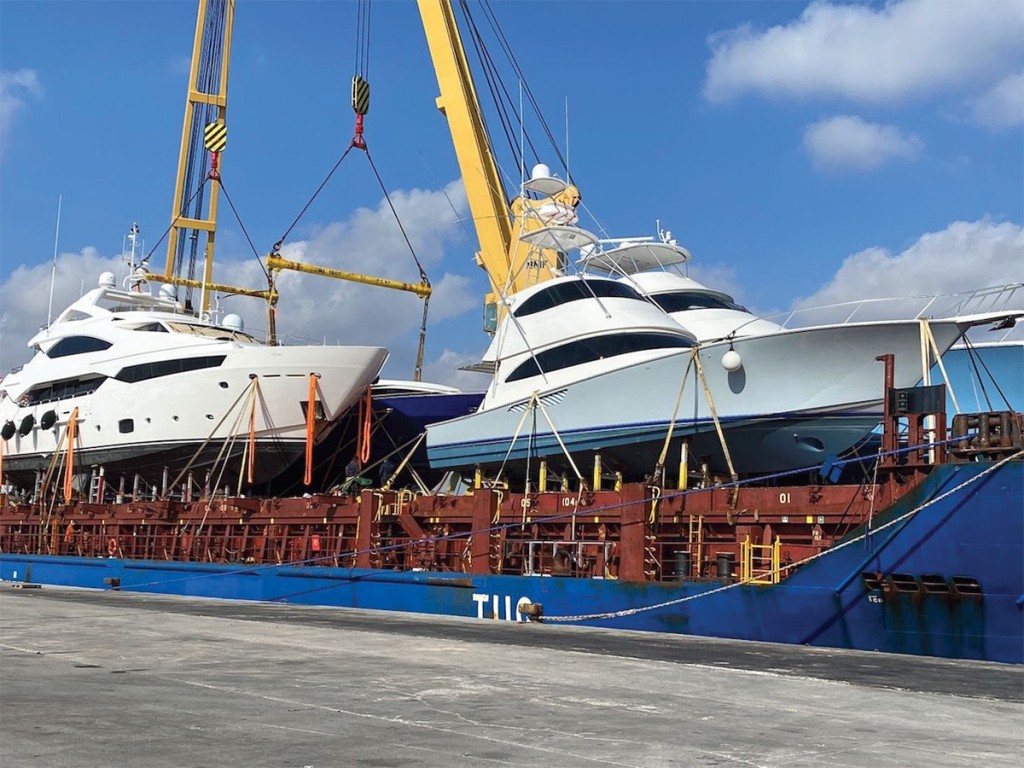Miami-based Florida Maritime Transport (FMT) moves yachts all over the world. And as Founder and CEO Dmitry Faber explains in an exclusive interview with AJOT, it is a highly specialized niche of the heavy lift/project cargo market.

AJOT: When you went into business for yourself in 2012, do you remember putting together your first voyage for yacht transport?
Dmitry Faber: Yes, it was Fall of 2012. We hired from SAL a heavy lift vessel and loaded 3 boats from Port Everglades to Korea which were Inace 85 trawler, Azimut 80 and Magnum 55 speed boat. Interestingly enough, I did not have experience in chartering and the clauses where yacht transporters usually inform the ship owners that no other yachts booked by other [transporters]are allowed to be loaded on the vessel and all yacht bookings for the ship have to go though charter party. So, Rick Gladych with Raven offshore loaded 5 other boats on the same vessel, and I was surprised, as we paid for port call. And he was happy to [be able to] load his boats as well. In our industry, if you do not put a clause that yacht bookings on your voyage have to be booked through Charter party only, you lose marketing advantage and competition will try to load other yachts against you on the same vessel.

AJOT: Is there a seasonal cycle to yacht transport or is it a fairly consistent business year round?
Secondarily, are there certain key trade lanes in the yacht transport business?
Dmitry Faber: Yes, yachts head from Florida and the Caribbean to the Med (Spain, Italy, Greece, Turkey, and Adriatic) between March to June and coming back from Med/Adriatic in the fall from September to December. Same with North America – in the spring yachts head to the Pacific Northwest, Mexico and California for the summer and in the fall coming back to Florida and the Caribbean. We have had 4 sailings in/out of Great Lakes from Florida departing in May/offloading in Sarnia, Ontario and coming back in September/October to bring yachts back who cruise the Great Lakes in the summer. The Great Lakes offers some of the best cruising in the summer around Mackinac Island, Petoskey, MI. With places like Bay Harbor Yacht Club, where most of our yacht owners hang out and have slips in the summer and in the winter. They like Ocean Reef Club in the Florida Keys.
We had been blessed to work with Jordan Tilton of JTA Yacht Deliveries and Consulting who grew up in the Midwest and has been offering crew delivery services to many yacht owners in/out of Great Lakes via St Lawrence Seaway, Erie Canal or Hudson River north and south. Jordan and I became great friends, and we offer clients the option to ride the ship or have Jordan’s crew deliver yachts on their own bottom. For those fortunate enough to be in Europe, cruising Balearic Sea, Adriatic Sea, Aegean Sea between Spain/Italy/Greece/Turkey/Slovenia is some of the best in the world. Pacific Northwest has put good effort into attracting more yachts for the summer here and had done well with trade shows. Special thanks go to Northwest Yacht Brokers Association who had been very active with promoting yachting in the Pacific Northwest and doing a great job advocating with the city and state municipalities for boating rights and infrastructure. FMT opened an office in Seattle in 2022 and has enjoyed being part of PNW culture.
Additional key trade lanes are the USA and Med to Asia/Hong Kong/Indonesia/Singapore with some great cruising grounds there in the winter and also coming back from Asia to USA and Med in the summer. I love cruising opportunities in Asia as the Indonesian archipelago provides truly pristine waters, more remote areas for those fortunate enough to own bigger yachts and trawlers with long range of navigation. Phuket [in Thailand] is also amazing.

AJOT: How did you come to decide on using an asset light “chartering” business model when you launched FMT Yacht Transport? Any thoughts on changing the business model with FMT Yacht Transport owning or moving into a long-term charter on a vessel?
Dmitry Faber: It came based on supply and demand. We started by booking yachts with other charterers in North America and Med and Caribbean and then when we saw that we have more than 7-10 boats on every vessel. We chartered our own vessels to have more control on schedule and offer clients our model of coordination, extra services like shrinkwrap, captains to / from vessels, my attendance onboard and smiling to clients from the ship and covering all aspects of yacht transport from marina to ship to marina as turnkey services. We looked into long term chartering in 2020 and 2021 and due to time charter rates being at all-time highs had decided to wait. It is my dream to own cargo vessels and to put them on dedicated trade lines with the cargo hold used for brokers and friends to move other commodities, and decks for yachts to give the yachting community predictable schedules, so they can plan ahead and know that our ships will always come.
AJOT: Given that yacht transportation is such a niche business, is there a repeat “customer” element to the yacht transport market?
Dmitry Faber: Of course, most of our bookings are referrals and repeat customers. We have a pretty good retention rate. Many clients are interested to sign round trip bookings to/from key trades so they can plan their summers/winters always chasing sunny days and best weather and we see owners spending 6 months in Florida and 6 months in the Med or Asia or PNW. It is always a bit frustrating and more challenging with some brokerages, clients and yacht management companies who have the rule to ask 7 quotes from the entire industry before deciding to book even though they shipped with one or other company before. But we try to build value instead of negative sale tactics as some other companies are using when booking yachts.
AJOT: I understand that you use a combination of liner containerships, ro/ro, and specialized and breakbulk carriers to transport the yachts. What goes into the decision making to determine which type of vessel is deployed?
Dmitry Faber: Mainly clients timetable and route. In key routes as we discussed above, it is always more convenient to load with our charter lift on vessel, however if a client has unique port requirements or an urgent timetable, liner service works amazing to meet any goal.
AJOT: What specialized equipment is used in the loading and discharge of the yachts? Do you have to deploy personnel to oversee the process?
Dmitry Faber: It is a humongous effort to put loading together and make it smooth. We employ loadmasters (MHL mainly as they are the best in the industry), also on any typical ship we have 5 crews working side by side: loadmasters, stevedores, divers, welders, owner’s crews. All loving each other and singing kumbaya behind a round table most of the time. Each crew is integral to the operation, and each is respected and cherished by FMT.
AJOT: What was the largest yacht your company moved? And were there any unique engineering demands for the movement?
Dmitry Faber: 165’ x 30’ /450 tons so far, engineering requirements included custom lift plan and equipment plan, getting same approved by vessel owners, yacht owners and their architects and all while trying to make it happen yesterday as the yacht was late to the Med.
AJOT: What is the average cost of moving a yacht? What are some of the main factors?
Dmitry Faber: Rates had gone up about 30-40% since the pandemic and now there is some tendency of rates equalizing, mainly due to ship hire rates soaring during 2021-2022. As of today, Yacht transport Math 101, you can say about 1,200 USD per foot to the Med for yachts up to 80’ LOA and more for heavy and super yachts. In North America and Asia coming eastbound is more expensive as ships are still full coming out of Asia. We do have a crafty tool on our website: https://fmtyachttransport.com/ where one can enter route and dimensions and receive instant ballpark quote which yacht owners appreciate.
AJOT: Besides the actual transportation of the yachts, what other services are involved in the business?
Dmitry Faber: Auxiliary services like crew delivery to / from vessel, transient berthing while yachts wait for staging the few days waiting for the ship to come, shrinkwrap, customs clearance, special protection for yacht’s gel coats, detailing are some of the few. Also chartering yachts and offering owners to move their yachts to/from different cruising grounds with purpose to charter for profit and use by owners when needed.
AJOT: Given the delicate and expensive nature of yacht transport is there any special insurance for the moves?
Dmitry Faber: All Cargo Risk Marine Insurance provided by British or German syndicates is a must as it covers all risks from slings to slings while the yacht is being loaded, shipped, and offloaded from cargo vessels. The typical cost to an owner is 0.25% of the yacht’s insured value +/- for the policy.
AJOT: COVID-19 drastically disrupted global supply chains. How did the pandemic effect the yacht transport sector?
Dmitry Faber: It slowed down for about 8 months as we lost marinas and infrastructure in key areas and trade shows closed. However, it rebounded quickly and new orders for yachts started flowing into builders. The used yacht sales market exploded as all yacht owners figured they could use their yachts when nothing else is open and to have autonomy to sail anywhere if apocalypse happens. Or they made money in the stock market or elsewhere after economy started coming back.
AJOT: There seems to be a trend towards building larger yachts — is that something you’ve experienced in your business? What are some of the trends you see emerging in the sector?
Dmitry Faber: We see the trend for moving to renewable energy, hybrid motors, larger modern yachts and designs and even artificial intelligence (AI). Maritime industry is amazing and is one of the oldest industries in the world. It should be noted that it is one of the most traditional industries in terms of how business is done on relationships, and we still use terms like “steaming” and “bunkering” put in place when ships burned coal and were steam powered.

Follow us on social media: